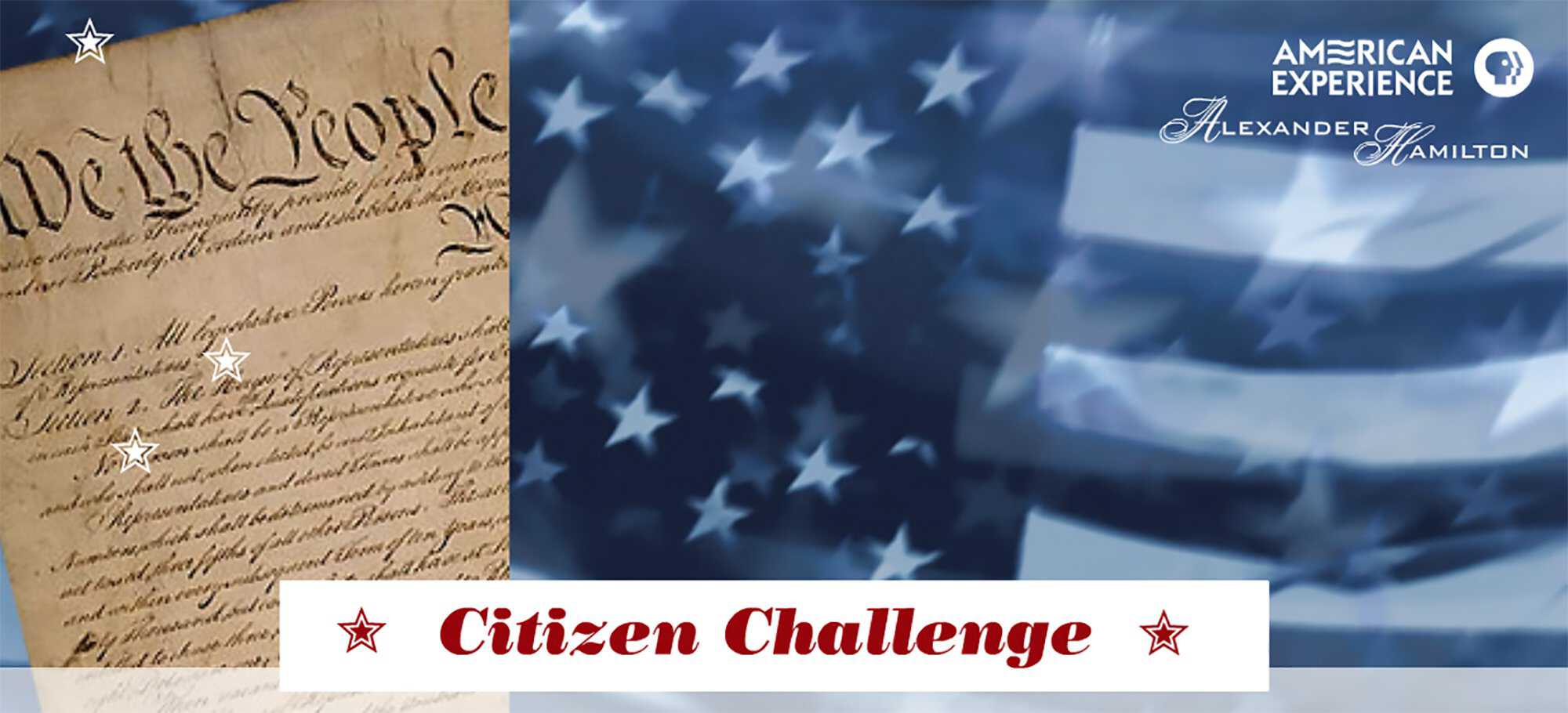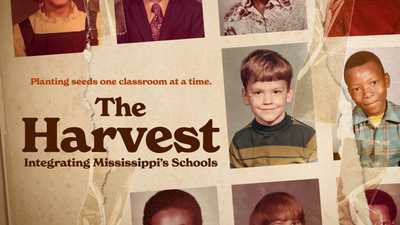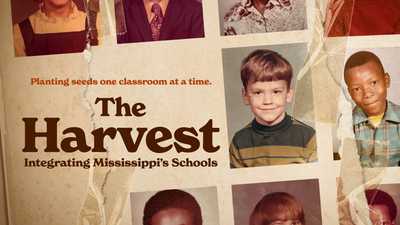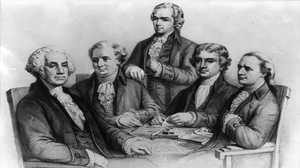Take the Citizenship Test

Alexander Hamilton developed the ideas of government and economy that are some of the core essentials of American citizenship. Immigrants to the U.S. who wish to become citizens must demonstrate a working knowledge of American government and history.
See how you do with some of the questions a petitioning citizen must answer.
From the list of 100 questions in English, an USCIS officer will ask you up to 10 questions. You must answer correctly 6 of the 10 questions to pass the civics test.
Test your knowledge of the U.S. with the selected list of questions below.
1. What country did we fight during the Revolutionary War?
A. France
B. Canada
C. England
2. Who elects the president of the United States?
A. The electoral college
B. The citizens of the United States
C. The U.S. Congress
3. How many states are there in the Union?
A. 48
B. 50
C. 52
4. Why are there 100 Senators in the Senate?
A. Two from each state
B. There are 100 seats on the Senate floor.
C. The Constitution says that there should be 100 Senators.
5. What is the name of the ship that brought the Pilgrims to America?
A. The Mayflower
B. Old Ironsides
C. The Santa Maria
6. Which president freed the slaves?
A. George Washington
B. Abraham Lincoln
C. James Monroe
7. When President Lincoln issued the Emancipation Proclamation in 1863, it brought about enormous social changes. Whose rights are guaranteed by the Constitution and the Bill of Rights?
A. Citizens of the United States
B. People living in North America
C. Everyone (citizens and non-citizens) living in U.S.
8. Who is the Commander in Chief of the U.S. military?
A. The General of the Army
B. The President
C. The Secretary of Defense
9. What is the national anthem of the United States?
A. America the Beautiful
B. The Battle Hymn of the Republic
C. The Star Spangled Banner
10. What is a minimum voting age in the United States?
A. Eighteen (18)
B. Twenty-one (21)
C. Twenty (20)
11. Which president is called the "father of our country”?
A. Thomas Jefferson
B. George H.W. Bush
C. George Washington
12. Where does the freedom of speech come from?
A. The Ten Commandments
B. The Fourth Estate
C. The Bill of Rights
13. Who signs bills in law?
A. The President
B. The Congress
C. The Supreme Court
14. For how long do we elect the president?
A. Eight years
B. Two years
C. Four years
15. What do we call a change to the Constitution?
A. An Amendment
B. A Ratification
C. A High Court Ruling
16. How many branches are there in our government?
A. 2
B. 3
C. 4
17. In what month is the new president inaugurated?
A. March
B. November
C. January
18. Name the right guaranteed by the first amendment?
A. Freedom of: speech, press, religion, peaceable assembly, and requesting change of the government.
B. The right to bear arms.
C. The right to Life Liberty and the Pursuit of Happiness
19. Who wrote the Star-Spangled Banner?
A. Betsy Ross
B. Francis Scott Key
C. John Philip Sousa
20. Who was president during the Civil War?
A. James Buchanan
B. Woodrow Wilson
C. Abraham Lincoln
21. What did the Emancipation Proclamation do?
A. Freed many slaves
B. Ended the Civil War
C. Emancipated Southern states
22. What special group advises the president?
A. The Congress
B. The Party Caucus
C. The Cabinet
23. What is the legislative branch of our government?
A. The Supreme Court
B. The Congress
C. The Senate
24. Who makes the laws in the United States?
A. The Executive Branch
B. The Supreme Court
C. The Congress
25. What is the Congress?
A. The Senate and the House of Representatives
B. The Executive Branch
C. The Democratic and Republican Parties
26. Who elects the Congress?
A. The people
B. The state governments
C. The electoral college
27. What is the supreme law of the land?
A. The Constitution
B. The Articles of Confederation
C. The Executive Orders
28. When was the Declaration of Independence adopted?
A. July 4, 1776
B. May 31, 1776
C. July 4, 1774
29. What do we call the first ten amendments to the Constitution?
A. The Preamble
B. The Bill of Right
C. The Magna Carta
30. What are the three branches or parts of the government?
A. Executive, legislative and judicial
B. The Senate, House of Representatives and the White House
C. Executive, Electoral College and Congress
31. How many U.S. Senators does each state have?
A. Two (2)
B. It depends on the state population.
C. Four (4)
32. Who is in charge of the executive branch?
A. The president
B. The secretary of state
C. The chief justice of the Supreme Court
33. What determines each state's number of U.S. Representatives?
A. The population of the state.
B. The constitution of the state.
C. It is a fixed number in the Constitution.
34. How old must a president be?
A. At least fifty-five (55)
B. There is no age limit.
C. At least thirty-five (35)
35. If the president can no longer serve, who becomes president?
A. The speaker of the House
B. The vice president
C. The secretary of state
36. Who becomes president if both the president and the vice president can no longer serve?
A. The secretary of state
B. The Supreme Court decides
C. The speaker of the House
37. How many full terms can a president serve?
A. Unlimited
B. Two (2)
C. Three (3)
38. Who signs bills to become laws?
A. The speaker of the House.
B. The president
C. Chief Justice of the Supreme Court
39. Who vetoes bills?
A. The president
B. The Supreme Court
C. The Speaker of the House
40. Who confirms Supreme Court justices?
A. The Senate
B. House of Representatives
C. Justices are nominated and not confirmed
41. In what month are general presidential elections held in the U.S.?
A. November
B. It varies from election to election.
C. January
42. What is the Pledge of Allegiance?
A. An oath to uphold the law of the land
B. A statement of honor written by Benjamin Franklin
C. The promise of loyalty to the flag and the nation
43. Who can vote in the U.S. presidential elections?
A. All registered citizens 18 years of age and older
B. All citizens 21 years of age and older
C. All citizens 16 years of age with a valid driver's license
44. When is the last day of the year you can send in federal income tax forms?
A. April 15
B. It varies every year.
C. December 31
Answers:
1. Answer: C. England
A. No. American colonists rebelled against
B. No. American colonists rebelled against
C. Right. American colonists rebelled against
2. Answer: A. The electoral college
A. Right. Voters choose their electoral delegates when they vote for president and vice president. The electoral delegates from all the states vote to decide who will be president.
B. No. Voters choose their electoral delegates when they vote for president and vice president. The electoral delegates from all the states vote to decide who will be president.
C. No. Voters choose their electoral delegates when they vote for president and vice president. The electoral delegates from all the states vote to decide who will be president. Congress certifies their votes.
3. Answer: B. 50
A. No. Alaska and Hawaii joined the Union in 1959 bringing the number of states to 50.
B. Right. Alaska and Hawaii joined the Union in 1959 bringing the number of states to 50.
C. No. Alaska and Hawaii joined the Union in 1959 bringing the number of states to 50. There are 52 cards in a deck, though.
4. Answer: A. Two from each state
A. Right. This was defined by the Constitution.
B. No. There may be 100 seats but that is because the Constitution proscribed two from each state.
C. No. In 1850 when there were XX states in the Union there were XX senators.
5. Answer: A. The Mayflower
A. Right. The 180-ton sailing ship The Mayflower carried 37 pilgrims to Plimoth in December 1620.
B. No. Old Ironsides, or more formally the U.S.S. Constitution, is one of the first naval frigates launched in 1797.
C. No. The 180-ton sailing ship The Mayflower carried 37 pilgrims to Plimoth in December 1620.
6. Answer: B. Abraham Lincoln.
A. No. Abraham Lincoln issued the Emancipation Proclamation in 1863.
B. Right. Abraham Lincoln issued the Emancipation Proclamation in 1863.
C. No. Abraham Lincoln issued the Emancipation Proclamation in 1863.
7. Answer: C. Everyone (citizens and non-citizens) living in U.S.
A. No. Everyone living in the U.S. (citizens and non-citizens) are guaranteed by the Constitution and the Bill of Rights.
B. No. Everyone living in the U.S. (citizens and non-citizens) are guaranteed by the Constitution and the Bill of Rights.
C. Right. Everyone living in the U.S. (citizens and non-citizens) are guaranteed by the Constitution and the Bill of Rights.
8. Answer: B. The President
A. No, that's not right. Beginning with George Washington, the president has been the Commander in chief.
B. That's right. Beginning with George Washington, the president has been the Commander in chief.
C. No, that's not right. Beginning with George Washington, the president has been the Commander in chief.
9. Answer: C. The Star Spangled Banner
A. No, that's not right. Congress made the Star Spangled Banner the U.S. national anthem in 1931.
B. No, that's not right. Congress made the Star Spangled Banner the U.S. national anthem in 1931.
C. Right! Congress made the Star Spangled Banner the U.S. national anthem in 1931.
10. Answer: A. Eighteen (18)
A. Gold Star! You are correct. The 26th Amendment to the Constitution in 1971 lowered the voting age for federal and state election from 21 to 18.
B. No, that's not right. The 26th Amendment to the Constitution in 1971 lowered the voting age for federal and state election from 21 to 18.
C. No, that's not right. The 26th Amendment to the Constitution in 1971 lowered the voting age for federal and state election from 21 to 18.
11. Answer: C. George Washington
A. No, that's not right. Commander in Chief in the American Revolution and first president George Washington is known as "the father of our country."
B. No, that's not right. Commander in Chief in the American Revolution and first president George Washington is known as "the father of our country."
C. You are right! Commander in Chief in the American Revolution and first president George Washington is known as "the father of our country."
12. Answer: C. The Bill of Rights
A. No, that's not right. The American right to freedom of speech is granted in the first amendment in the Bill of Rights.
B. No, that's not right. The American right to freedom of speech is granted in the first amendment in the Bill of Rights.
C. Right! The American right to freedom of speech is granted in the first amendment in the Bill of Rights.
13. Answer: A. The President
A. Gold Star! You are correct. After Congress votes and passes bills, the president signs them into law.
B. No, that's not right. After Congress votes and passes bills, the president signs them into law.
C. No, that's not right. After Congress votes and passes bills, the president signs them into law.
14. Answer: C. Four years
A. No, that's not right. According to Article 2 of the Constitution, the president is elected to a four-year term.
B. No, that's not right. According to Article 2 of the Constitution, the president is elected to a four-year term.
c. You are right! According to Article 2 of the Constitution, the president is elected to a four-year term.
15. Answer: A. An Amendment
A. Right! Changes to the Constitution are called Amendments. The first 10 amendments, known as the Bill of Rights, were ratified in 1791.
B. No, that's not right. Changes to the Constitution are called Amendments. The first 10 amendments, known as the Bill of Rights, were ratified in 1791.
C. No, that's not right. Changes to the Constitution are called Amendments. The first 10 amendments, known as the Bill of Rights, were ratified in 1791.
16. Answer: B. 3
A. No, that's not right. The framers of the Constitution established a system of check and balances by creating three branches of government.
B. Gold Star! You are correct. The framers of the Constitution established a system of check and balances by creating three branches of government.
C. No, that's not right. The framers of the Constitution established a system of check and balances by creating three branches of government.
17. Answer: C. January
A. No, that's not right. Since 1937 newly elected presidents have celebrated their inaugurations in January.
B. No, that's not right. Since 1937 newly elected presidents have celebrated their inaugurations in January.
C. You are right! Since 1937 newly elected presidents have celebrated their inaugurations in January.
18. Answer: A. Freedom of: speech, press, religion, peaceable assembly, and requesting change of the government.
A. Right! The first amendment, drafted by James Madison, guarantees the fundamental rights of freedom of speech, religion, peaceable assembly, and requesting change of the government.
B. No, that's not right. The first amendment, drafted by James Madison, guarantees the fundamental rights of freedom of speech, religion, peaceable assembly, and requesting change of the government.
C. No, that's not right. The first amendment, drafted by James Madison, guarantees the fundamental rights of freedom of speech, religion, peaceable assembly, and requesting change of the government.
19. Answer: B. Francis Scott Key
A. No, that's not right. In 1814, after witnessing the British bombardment of Fort McHenry, Francis Scott Key wrote the words to the song that became the national anthem.
B. Gold Star! You are correct. In 1814, after witnessing the British bombardment of Fort McHenry, Francis Scott Key wrote the words to the song that became the national anthem.
C. No, that's not right. In 1814, after witnessing the British bombardment of Fort McHenry, Francis Scott Key wrote the words to the song that became the national anthem.
20. Answer: C. Abraham Lincoln
A. No, that's not right. The Civil War began in 1861 not long after Abraham Lincoln became president.
B. No, that's not right. The Civil War began in 1861 not long after Abraham Lincoln became president.
C. Correct! The Civil War began in 1861 not long after Abraham Lincoln became president.
21. Answer: A. Freed many slaves.
A. Right! In January 1863, the Emancipation Proclamation freed slaves in Confederate states, two years before the end of the Civil War.
B. No, that's not right. In January 1863, the Emancipation Proclamation freed slaves in Confederate states, two years before the end of the Civil War.
C. No, that's not right. In January 1863, the Emancipation Proclamation freed slaves in Confederate states, two years before the end of the Civil War.
22. Answer: C. The Cabinet
A. No, that's not right. The Cabinet, made up of the heads of the executive branch departments, advises the president on their respective areas.
B. No, that's not right. The Cabinet, made up of the heads of the executive branch departments, advises the president on their respective areas.
C. Gold Star! You are correct. The Cabinet, made up of the heads of the executive branch departments, advises the president on their respective areas.
23. Answer: B. The Congress
A. No, that's not right. The Senate and the House of Representatives, together known as Congress, make up the legislative branch of our government.
B. You are right! The Senate and the House of Representatives, together known as Congress, make up the legislative branch of our government.
C. No, that's not right. The Senate and the House of Representatives, together known as Congress, make up the legislative branch of our government.
24. Answer: C. Congress
A. No, that's not right. The elected members of the two houses of the U.S. Congress, the House of Representatives and the Senate, make the laws.
B. No, that's not right. The elected members of the two houses of the U.S. Congress, the House of Representatives and the Senate, make the laws.
C. Right! The elected members of the two houses of the U.S. Congress, the House of Representatives and the Senate, make the laws.
25. Answer: A. The Senate and the House of Representatives
A. Gold Star! You are correct. The Congress is made up of the Senate and the House of Representatives. The most members of Congress belong to either the Democratic or Republican party.
B. No, that's not right. The Congress is made up of the Senate and the House of Representatives. The most members of Congress belong to either the Democratic or Republican party.
C. No, that's not right. The Congress is made up of the Senate and the House of Representatives. The most members of Congress belong to either the Democratic or Republican party.
26. Answer: A. the people
A. Correct! Members of Congress are elected from each state by popular vote.
B. No, that's not right. Members of Congress are elected from each state by popular vote.
C. No, that's not right. Members of Congress are elected from each state by popular vote.
27. Answer: A. The Constitution
A. Right! The U.S. Constitution has been the law of the land since its ratification in 1788.
B. No, that's not right. The U.S. Constitution has been the law of the land since its ratification in 1788.
C. No, that's not right. The U.S. Constitution has been the law of the land since its ratification in 1788.
28. Answer: A: July 4, 1776
A. Gold Star! You are correct. The Declaration of Independence, proclaiming the American colonies to be a sovereign nation, was adopted on July 4, 1776.
B. No, that's not right. The Declaration of Independence, proclaiming the American colonies to be a sovereign nation, was adopted on July 4, 1776.
C. No, that's not right. The Declaration of Independence, proclaiming the American colonies to be a sovereign nation, was adopted on July 4, 1776.
29. Answer: B. The Bill of Rights
A. No, that's not right. The first ten amendments, added to the Constitution in 1791, are known collectively as the Bill of Rights.
B. Gold Star! You are correct. The first ten amendments, added to the Constitution in 1791, are known collectively as the Bill of Rights.
C. No, that's not right. The first ten amendments, added to the Constitution in 1791, are known collectively as the Bill of Rights.
30. A. Right! The framers Constitution established the separation of power in the government with the executive, legislative and judicial branches of government.
B. No, that's not right. The framers Constitution established the separation of power in the government with the executive, legislative and judicial branches of government.
C. No, that's not right. The framers Constitution established the separation of power in the government with the executive, legislative and judicial branches of government.
31. Answer: Two (2)
A. You are right! Each state elects two senators to the U.S. Congress.
B. No, that's not right. Each state elects two senators to the U.S. Congress.
C. No, that's not right. Each state elects two senators to the U.S. Congress.
32. Answer: A
A. Gold Star! You are correct. The president is in charge of the executive branch.
B. No, that's not right. The president is in charge of the executive branch.
C. No, that's not right. The president is in charge of the executive branch.
33. Answer: A
A. Right! The federal government conducts a census every ten years to count how many residents live in each state to determine how many representatives come from that state.
B. No, that's not right. The federal government conducts a census every ten years to count how many residents live in each state to determine how many representatives come from that state.
C. No, that's not right. The federal government conducts a census every ten years to count how many residents live in each state to determine how many representatives come from that state.
34. Answer: C. At least thirty-five (35)
A. No, that's not right. The U.S. Constitution states that no person shall be eligible to the Office of President "who shall not have attained to the Age of thirty-five Years."
B. No, that's not right. The U.S. Constitution states that no person shall be eligible to the Office of President "who shall not have attained to the Age of thirty-five Years."
C. Correct! The U.S. Constitution states that no person shall be eligible to the Office of President "who shall not have attained to the Age of thirty-five Years."
35. Answer: B. The vice president
A. No, that's not right. The 25th Amendment to the Constitution says that the vice president shall become President if the President can no longer serve.
B. Right! The 25th Amendment to the Constitution says that the vice president shall become President if the President can no longer serve.
C. No, that's not right. The 25th Amendment to the Constitution says that the vice president shall become President if the President can no longer serve.
36. Answer: C. The speaker of the House.
A. No, that's not right. The framers did not put this in the Constitution, but it was later determined that the speaker of the House would become president in this case.
B. No, that's not right. The framers did not put this in the Constitution, but it was later determined that the speaker of the House would become president in this case.
C. Yes, that right. The framers did not put this in the Constitution, but it was later determined that the speaker of the House would become president in this case.
37. Answer: Two (2)
A. No, that's not right. The 22nd Amendment to the Constitution limited that number of terms a president could serve to two.
B. You are right! The 22nd Amendment to the Constitution limited that number of terms a president could serve to two.
C. No, that's not right. The 22nd Amendment to the Constitution limited that number of terms a president could serve to two.
38. Answer: B. The president
A. No, that's not right. After the House of Representatives and the Senate pass a bill, the president signs it into law.
B. You are right! After the House of Representatives and the Senate pass a bill, the president signs it into law.
C. No, that's not right. After the House of Representatives and the Senate pass a bill, the president signs it into law.
39. Answer: A. The President
A. Right! After the House of Representatives and the Senate pass a bill, the president can veto it if he/she does not approve of it.
B. No, that's not right. After the House of Representatives and the Senate pass a bill, the president can veto it if he/she does not approve of it.
C. No, that's not right. After the House of Representatives and the Senate pass a bill, the president can veto it if he/she does not approve of it.
40. Answer: A. The Senate
A. Gold Star! You are correct. The framers of the Constitution hoped to avoid corruption of power by giving the president the right to nominate and the Senate the right to confirm Supreme Court Justices.
B. No, that's not right. The framers of the Constitution hoped to avoid corruption of power by giving the president the right to nominate and the Senate the right to confirm Supreme Court Justices.
C. No, that's not right. The framers of the Constitution hoped to avoid corruption of power by giving the president the right to nominate and the Senate the right to confirm Supreme Court Justices.
41. Answer: A. November
A. You are right! General elections for president are held in November to allow for the largely agrarian population (way back when) to get in the harvest and travel before winter set in.
B. No, that's not right. General elections for president are held in November to allow for the largely agrarian population (way back when) to get in the harvest and travel before winter set in.
C. No, that's not right. General elections for president are held in November to allow for the largely agrarian population (way back when) to get in the harvest and travel before winter set in.
42. Answer: C. The promise of loyalty to the flag and the nation
A. No, that's not right. It is a promise of loyalty to the flag and the nation. It was first used in public schools in on Columbus Day 1892.
B. No, that's not right. It is a promise of loyalty to the flag and the nation. It was first used in public schools in on Columbus Day 1892.
C. Correct! It is a promise of loyalty to the flag and the nation. It was first used in public schools in on Columbus Day 1892.
43. Answer: A. All registered citizens 18 years of age and older
A. Gold star! You are correct. The 26th Amendment to the Constitution, added in 1971, lowered the voting age to 18.
B. No, that's not right. The 26th Amendment to the Constitution, added in 1971, lowered the voting age to 18.
C. No, that's not right. The 26th Amendment to the Constitution, added in 1971, lowered the voting age to 18.
44. Answer: A. April 15
A. Correct! April 15 has been the deadline for filing income tax forms since 1954.
B. No, that's not right. April 15 has been the deadline for filing income tax forms since 1954.
C. No, that's not right. April 15 has been the deadline for filing income tax forms since 1954.
Visit U.S. Citizenship and Immigration Services (USCIS) to test your Civics Practice Test.







